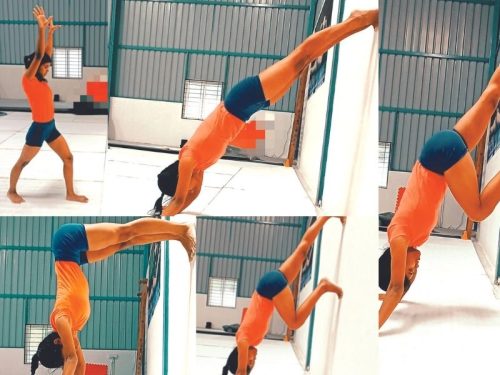Handstands: Upside down Benefits
Inversion exercises such as handstands and headstands greatly improve spine health and the lymphatic system by removing body toxins, writes Monojit Ghosh
Many physical fitness workout programmes including pilates, yoga, and gymnastics, incorporate inversion exercises such as headstands, handstands, mountain positions and rolls. The species homo sapiens is constantly on its feet. Inversion exercises help to turn things around and greatly improve spine health and the lymphatic system by removing body toxins. They also aid in digestion by stimulating peristaltic movement and blood flow to the digestive organs.

HANDSTAND
Handstand is perhaps the most important inversion exercise. At first, it might seem a superhuman stunt but with training and practise people of all ages can do it safely.
To do a handstand, you need flexibility, core, arm and shoulder strength. You also need to develop shoulder and wrist mobility.
To learn safely and gradually, take wall support. Even advanced handstands need wall support for body balance.
HANDSTAND BENEFITS
- Improves concentration and focus
- Builds upper body strength
- Enables body control
- Boosts immunity
- Enhances muscles flexibility
- Improves spinal and bone health
- Builds core strength
- Improves body balance
- Boosts blood circulation
- Aids digestion
HANDSTAND EXERCISE
- Stand with your back to the wall and bend down. Keep your palm down, and shift body weight to your hands.
- Walk your legs one by one up the wall.
- Keep hands steady and body tight
- When your legs reach the top, focus on getting the right position
THE RIGHT POSITION
- Fully extended wrist and elbows
- Shoulders pushed upwards
- Hips tight — squeeze your glutes
- Keep the back neutral – don’t arch
- Point your toes
- Look down between your palms
To do the perfect handstand, practice the following exercises:

L stand
Stand before a wall and place your palms on it. Ensure palm to hip is in one straight line and hip to feet is aligned. Straighten shoulders and keep body shape in hollow position, with chest and stomach tucked inwards.
Now, do the same position upside down, with your palm on the floor. Here too, you need to focus on getting the upper body position right. Your shoulder should be above your wrist and stretched upwards.

Decline stand
Stand against the wall, keep your palms on the floor and slowly place one leg on the wall. Then lift both legs as high as you can. Move your hands forwards and make a declined position. This builds arm strength.

Walking handstand
Stand against the wall and lift your legs to a position above your head, with shoulder stretched, glutes tight, hollow body shape, pointed toes, and back straight. Then slowly walk your legs down the wall and up again.

One leg kick
From standing position, take the lunge position with your hands straight, decide which leg is comfortable to kick back. Next stretch your body and keep your hands down and kick your back leg. When you are kicking, try to take your body weight slowly onto your hands. Keep your head between your shoulders, and look down to the floor.
These handstand-related drills are helpful. But to do a handstand without any support, get help from a professional.
Caution: If you suffer from high blood pressure, spinal cord-related problems, or acid reflux, avoid handstands and consult your doctor before undertaking any of these exercises.
(Monojit Ghosh is a former gymnast and fitness trainer and gymnastics coach at Art Corner Gymnastics Academy, Bangalore)
Also Read: Exercise right to prevent knee pain

















Add comment